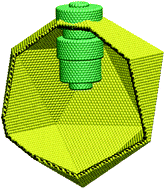Viral assembly: a molecular modeling perspective
Abstract
Icosahedral viruses are among the smallest and simplest of biological systems. The investigation of their structures represented the first step toward the establishment of molecular biophysics, over half a century ago. Many research groups are now pursuing investigations of viral

- This article is part of the themed collection: Nucleic acid simulations

 Please wait while we load your content...
Please wait while we load your content...